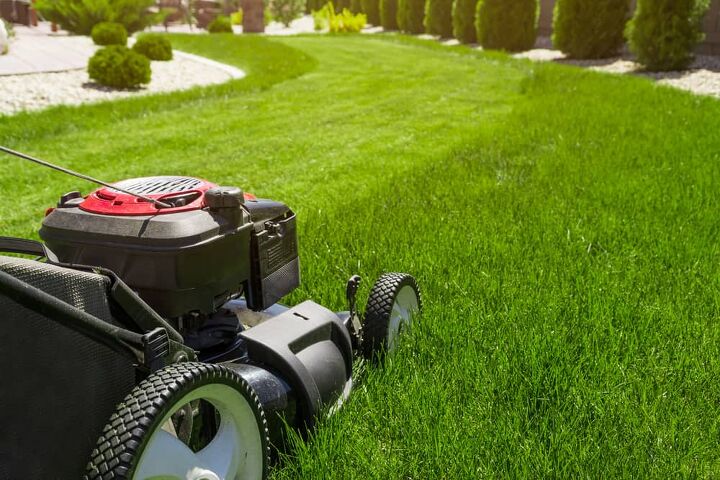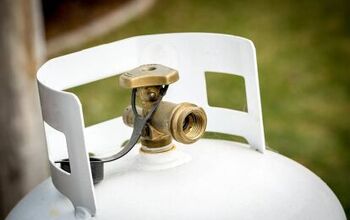Lawnmower Loses Power When Cutting? (Possible Causes & Fixes)

Usually, when mowing your lawn, the biggest problem you have to worry about is the heat and how long it will take to cut the grass. However, sometimes, you might run into more problems. Since lawnmowers are relatively complex machines, they can wear down over time. If you notice that your mower is shutting off or losing power while cutting, it could be a sign of some potentially serious issues.
Inspect the air filter for debris such as grass and dirt, and clean or replace it. Raise the cutting deck if it is too low and causes the mower to shut off during operation. Make sure that your mower has the proper kind of oil, such as SAE-30, so that it runs smoothly and stays on.
This article will dive deep into each potential problem and show you how to fix it. We will start with the easiest solutions and work our way up to the more complex options. If you don’t feel comfortable tinkering with your mower’s engine, we recommend taking it to a repair shop. However, it may not get to that point, so start small and go from there.
Do You Need a Mower Repair Service?
Get free, zero-commitment quotes from pro contractors near you.

Top 5 Reasons Why a Lawnmower Loses Power When Cutting
Problem 1: Cutting Deck Too Low
If you’ve ever paid attention to your grass, you know that it can sometimes be extra thick or thin and patchy. The species of grass in your lawn makes a huge difference in how easy it is to mow. Ideally, if you’re cutting it regularly (i.e., weekly or bi-weekly), it shouldn’t get out of control. However, that is often easier said than done.
Because your lawnmower doesn’t have tons of horsepower at its disposal, the crankshaft (which drives the engine) can stall relatively quickly. So, if you’re trying to cut too much at once, the machine will cut out almost immediately. Even if you restart the mower and try again, it will keep happening.
Solution: Raise the Cutting Deck
While we usually recommend taking the most efficient route with mowing, you might have to do a couple of passes to get the height you want. Raise the cutting deck and see if that improves the situation. Yes, you’ll have to go over your grass twice, but it will be much faster than having your machine stall every few feet. Also, there’s no reason you can’t mow on different days to make the job easier.
If raising the deck doesn’t solve the problem right away, be sure to clear the blades and the rest of the deck (while the mower is off, of course). Dirt and debris can get clogged under there, making it harder for the blades to spin.
Problem 2: Clogged Air Filter
If you’re sure that the cutting deck is not the problem or adjusted it and the mower still cuts off, the culprit is likely the air filter. Like your car, this component allows air into the engine, where it mixes with gasoline for combustion. If the filter is clogged and dirty, not enough oxygen can get into the system, which causes the motor to stall. Usually, the lawnmower will work by itself with a dirty air filter, but once you try doing anything with it, the whole machine will poop out.
Solution: Clean or Replace Your Air Filter
Fortunately, changing your mower’s air filter is a cheap and easy process. This component’s location will vary based on your specific make and model, so we recommend referring to your owner’s manual if you can. If you don’t have the manual or can’t find it, you can look up your mower online, and you should be able to download a copy.
Typically, all it takes is a screwdriver to open the housing unit for the filter, so you don’t need to buy any special tools. In almost all cases, we suggest replacing the filter rather than cleaning it. Since filters are inexpensive, it’s better to use a brand-new unit. Just make sure that you are buying the correct model for your lawnmower. If necessary, pull out the old filter and look it up by the serial number to find a suitable replacement.
Problem 3: Bad Oil/Incorrect Amount
We cannot stress enough how vital oil is to your lawnmower’s engine (or any combustion engine, really). Without this fluid, the inner machinery would overheat and break within minutes, turning your mower into little more than an expensive lawn ornament.
While oil is crucial, too much can be a bad thing. Too little is even worse, as it can cause friction within the engine, which will make it overheat. In extreme cases, the block may crack, or you might damage the crankshaft. If that occurs, you will likely have to buy a new lawnmower altogether.
Solution: Change Your Mower’s Oil
The first thing to do in this situation is to check the oil dipstick. Again, refer to your owner’s manual if you can’t find it. Whenever checking a dipstick (including for your car), you need to wipe off the oil and then dip it back into the tank. Doing this ensures that you get an accurate reading as oil expands and gets more viscous as it heats up.
If the level is low, all you have to do is add some more oil. However, before going into your garage, be aware that standard motor oil is not ideal for these kinds of engines. It might work in small doses, but you should use SAE-30 oil instead. You might have to buy some to top off your tank. If you have to keep refilling the oil, there is a leak, and you’ll have to fix it. However, that is for another article.
If the oil level is too high, you will have to remove some. Follow these steps to do it correctly.
- Step One: Park the Mower on a Hard, Flat Surface – A garage floor or driveway is ideal. If you haven’t been using it, we recommend running the engine for a couple of minutes to make it easier to drain the oil.
- Step Two: Disconnect the Spark Plug – Pull the ignition cable off of it.
- Step Three: Place a Drip Pan – Put it on the side where you will tilt the mower.
- Step Four: Tilt the Mower – If you are lifting the machine on its side, be sure to have the carburetor facing the sky (refer to your manual for its location). Alternatively, you can lift it from the handle until it is high enough for the oil to drain.
- Step Five: Check the Oil Level – Realistically, you will have drained too much oil. Check the level, add a little bit, and keep checking until it is correct. Fortunately, you can reuse the oil from the drip pan instead of buying more.
Problem 4: Dull Lawnmower Blades
As with any sharp edge, your mower blades will get dull over time. If you haven’t sharpened them in ages, they likely need some fine-tuning. While grass isn’t usually thick enough to warrant samurai-like blades, ones that are too dull won’t be able to hack through, causing the engine to stall.
Solution: Sharpen or Replace Your Blades
Depending on how you want to address this problem, you may need some specialized equipment. Fortunately, lawnmower blades are not too expensive, so you can buy some more. Many repair shops can also sharpen your blades for you for roughly the same price (or less) as new ones. Follow these steps to get the blades off.
- Step One: Lift or Tilt the Mower – We highly recommend lifting it from the back if possible, as that will make it harder for fluids to leak out.
- Step Two: Remove the Mounting Bolt – You should only need a socket wrench for this step.
- Step Three: Remove the Blades – Inspect them for cracks, rusting, and to see how dull they are.
If you have a machine grinder, you can sharpen the edges yourself. Find out more about how to do that here. Once you’re finished, replace the blades and test the mower.
Problem 5: A Faulty Spark Plug
When it comes to engine combustion, the spark plug is one of the most vital components. It ignites the air/fuel mixture at precisely the right moment. So, if it isn’t working correctly, your motor will stall out.
Solution: Change Your Spark Plug
This problem will require some specialized tools, including a spark plug socket and a feeler gauge. Usually, you can tell if the spark plug is giving you problems because the mower will cut out on its own (even when you’re not cutting), or it might have trouble starting. You can find out more about how to change a spark plug here.
Do You Need a Mower Repair Service?
Get free, zero-commitment quotes from pro contractors near you.

Related Questions
What if I have an electric lawnmower?
Usually, electric mowers will stop working while cutting because the battery isn’t strong enough to handle the load, or it is running out of juice. Similarly, your blades can be the cause if they are too dull.
I’ve tried these fixes, and it still loses power; what could it be?
We recommend taking your machine to a repair shop so that they can diagnose the problem. It could be a faulty carburetor or something more significant.

We are a team of passionate homeowners, home improvement pros, and DIY enthusiasts who enjoy sharing home improvement, housekeeping, decorating, and more with other homeowners! Whether you're looking for a step-by-step guide on fixing an appliance or the cost of installing a fence, we've here to help.
More by Upgraded Home Team











![10 Best Electric Pressure Washers – [2022 Reviews & Guide]](https://cdn-fastly.upgradedhome.com/media/2023/07/31/9070600/10-best-electric-pressure-washers-2022-reviews-guide.jpg?size=350x220)















